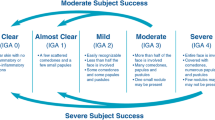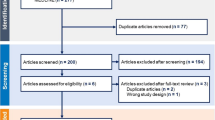Abstract
Adult acne vulgaris affects up to 43–51% of individuals. While there are numerous treatment options for acne including topical, oral, and energy-based approaches, benzoyl peroxide (BPO) is a popular over the counter (OTC) treatment. Although BPO monotherapy has a long history of efficacy and safety, it suffers from several disadvantages, most notably, skin irritation, particularly for treatment naïve patients. In this prospective, randomized, controlled, split-face study, we evaluated the comparative efficacy, safety, and tolerability of a novel 3-step azelaic acid, salicylic acid, and graduated retinol regimen versus a common OTC BPO-based regimen over 12 weeks. A total of 37 adult subjects with self-reported mild to moderate acne vulgaris were recruited. A total of 21 subjects underwent a 2-week washout period and completed the full study with 3 drop** out due to product irritation from the BPO routine, and 13 being lost to follow-up. Detailed tolerability surveys were conducted at Week 4. Additional surveys on tolerability and product preferences were collected monthly, at Week 4, Week 8, and Week 12. A blinded board-certified dermatologist objectively scored the presence and type of acne lesions (open or closed comedones, papules, pustules, nodules, and cysts) at baseline, Week 4, Week 8, and Week 12. Patients photographed themselves and uploaded the images using personal mobile phones. Detailed Week 4 survey results showed across 25 domains of user-assessed product performance, the novel routine outperformed the BPO routine in 19 (76%) which included domains in preference (e.g. “I would use this in the future) and performance (“my skin improved” and “helped my acne clear up faster”). Users of the novel routine reported less facial redness, itching, and burning, though differences did not reach statistical significance. In terms of efficacy, both products performed similarly, reducing total acne lesions by 36% (novel routine) and 40% (BPO routine) by Week 12. Overall, accounting for user preferences and tolerability the novel routine was more preferred than the BPO routine in 79% of domains (22/28). Differences in objective acne lesion reduction were not statistically significant (p = 0.97). In a randomized split-face study, a 3-step azelaic acid, salicylic acid, and graduated retinol regimen delivered similar acne lesion reduction, fewer user dropouts, greater user tolerability, and higher use preference compared to a 3-step BPO routine based in a cohort of participants with mild-to-moderate acne vulgaris.






Similar content being viewed by others
Data availability
The datasets generated and analyzed during the current study are available from the corresponding author on reasonable request.
References
Collier CN, Harper JC, Cafardi JA et al (2008) The prevalence of acne in adults 20 years and older. J Am Acad Dermatol 58(1):56–59
Samuels DV, Rosenthal R, Lin R, Chaudhari S, Natsuaki MN (2020) Acne vulgaris and risk of depression and anxiety: A meta-analytic review. J Am Acad Dermatol 83(2):532–541
Insights FB. U.S. Acne Treatment Market Size, Share & COVID-19 Impact Analysis. https://www.fortunebusinessinsights.com/u-s-acne-treatment-market-106565. Published 2023. Accessed October 10, 2023, 2023.
Tanghetti EA, Popp KF (2009) A current review of topical benzoyl peroxide: new perspectives on formulation and utilization. Dermatol Clin 27(1):17–24
Sevimli DB (2019) Topical treatment of acne vulgaris: efficiency, side effects, and adherence rate. J Int Med Res 47(7):2987–2992
Chen W, Dai R, Li L (2020) The prevalence of self-declared sensitive skin: a systematic review and meta-analysis. J Eur Acad Dermatol Venereol 34(8):1779–1788
Lucky AW, Barber BL, Girman CJ, Williams J, Ratterman J, Waldstreicher J (1996) A multirater validation study to assess the reliability of acne lesion counting. J Am Acad Dermatol 35(4):559–565
Williams HC, Dellavalle RP, Garner S (2012) Acne vulgaris. Lancet 379(9813):361–372
Fulton JE Jr, Farzad-Bakshandeh A, Bradley S (1974) Studies on the mechanism of action to topical benzoyl peroxide and vitamin A acid in acne vulgaris. J Cutan Pathol 1(5):191–200
Sagransky M, Yentzer BA, Feldman SR (2009) Benzoyl peroxide: a review of its current use in the treatment of acne vulgaris. Expert Opin Pharmacother 10(15):2555–2562
Matin T, Goodman MB (2023) Benzoyl Peroxide. In: StatPearls. Treasure Island (FL) ineligible companies. Disclosure: Marcus Goodman declares no relevant financial relationships with ineligible companies.2023
Araviiskaia E, Dreno B (2016) The role of topical dermocosmetics in acne vulgaris. J Eur Acad Dermatol Venereol 30(6):926–935
Schulte BC, Wu W, Rosen T (2015) Azelaic Acid: Evidence-based Update on Mechanism of Action and Clinical Application. J Drugs Dermatol 14(9):964–968
Gollnick H, Cunliffe W, Berson D et al (2003) Management of acne: a report from a Global Alliance to Improve Outcomes in Acne. J Am Acad Dermatol 49(1 Suppl):S1-37
Thiboutot D, Dreno B, Layton A (2008) Acne counseling to improve adherence. Cutis 81(1):81–86
Decker A, Graber EM (2012) Over-the-counter Acne Treatments: A Review. J Clin Aesthet Dermatol 5(5):32–40
Flanders PA, McNamara JR (1985) Enhancing acne medication compliance: a comparison of strategies. Behav Res Ther 23(2):225–227
Valisure (2024) Valisure discovers benzoyl peroxide acne treatment products are unstable and form benzene
Acknowledgements
None.
Funding
Regimen.
Author information
Authors and Affiliations
Contributions
AG collected data, analyzed data, and generated figures. SR oversaw data collection, IRB approval, and study conduct. SX wrote manuscript and analyzed results. JRW performed statistical analysis and provided critical revisions of the manuscript. PV supported data collection, made critical edits to the manuscript, and scored all raw data outputs.
Corresponding author
Ethics declarations
Competing interests
Shuai Xu has stock options and is a consultant of Geologie - the manufacturer of one of the products studied here. Jessica Walter has a spouse with stock options and a consultant of Geologie – the manufacturer of one of the products studied here.
Additional information
Publisher's Note
Springer Nature remains neutral with regard to jurisdictional claims in published maps and institutional affiliations.
Rights and permissions
Springer Nature or its licensor (e.g. a society or other partner) holds exclusive rights to this article under a publishing agreement with the author(s) or other rightsholder(s); author self-archiving of the accepted manuscript version of this article is solely governed by the terms of such publishing agreement and applicable law.
About this article
Cite this article
Gern, A., Walter, J., Xu, S. et al. A randomized controlled double-blinded split-face prospective clinical trial to assess the efficacy, safety, and tolerability of a novel 3-step routine compared to benzoyl peroxide for the treatment of mild to moderate acne vulgaris. Arch Dermatol Res 316, 230 (2024). https://doi.org/10.1007/s00403-024-02874-9
Received:
Revised:
Accepted:
Published:
DOI: https://doi.org/10.1007/s00403-024-02874-9




